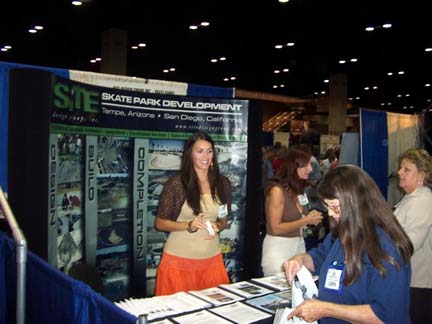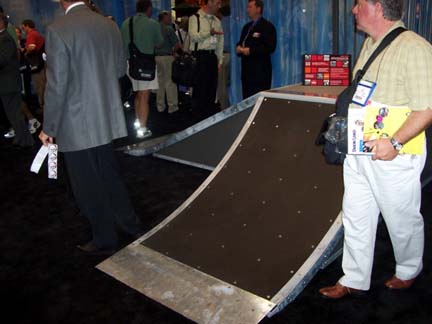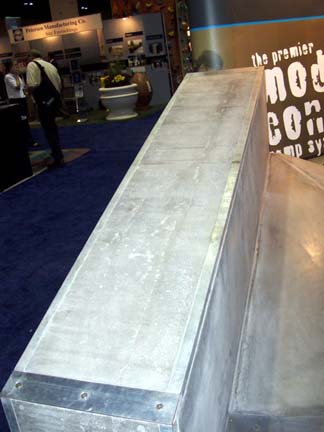NRPA Conference 2005: San Antonio
The first day I was able to sit in on a skatepark education session presented by KaBOOM. I arrived early and peeped in on some of the other education sessions and noticed 10-20 people in each room. When I got to the skatepark class it was packed. There must have been over a hundred Parks and Recreation employees from across the country jammed into this classroom…
On October 18-22 the NRPA (National Recreation and Parks Association) Conference was held in San Antonio, TX. For those that do not know the NRPA has been advocating the significance of making parks, open space, and recreational opportunities for over a 100 years. Every year they hold a conference in a different city across the nation, and thousands of Parks and Rec. officials from the all over the country attend to check out what’s hot in the world of parks and recreation. The event includes education sessions, park tours, and an exhibit hall with hundreds of vendors featuring the latest in recreation equipment.
 I was able to obtain a conference schedule of the entire event and was blown away by the amount of skatepark vendors attending the event. A majority of them I did not recognize and began with the word, “Play”. On top of that, the conference had set up education sessions about skatepark implementation and programming. This is all very interesting to some one like me who has been skateboarding for eighteen years and lobbying for public skateparks for over eight years.
I was able to obtain a conference schedule of the entire event and was blown away by the amount of skatepark vendors attending the event. A majority of them I did not recognize and began with the word, “Play”. On top of that, the conference had set up education sessions about skatepark implementation and programming. This is all very interesting to some one like me who has been skateboarding for eighteen years and lobbying for public skateparks for over eight years.
The first day I was able to sit in on a skatepark education session presented by KaBOOM. I arrived early and peeped in on some of the other education sessions and noticed 10-20 people in each room. When I got to the skatepark class it was packed. There must have been over a hundred Parks and Recreation employees from across the country jammed into this classroom.
Anyways the class was put together by KaBOOM. KaBOOM is a non-profit organization that, “…uses an innovative community-build model to bring together business and community interests to construct more than 850 new playgrounds and skateparks and renovate 1,300 others nationwide.” Hanh Le with KaBOOM hosted the class along with her partner and they went through the whole skatepark process which included educating city officials about funding, insurance, design, etiquette, maintenance and operations.
Afterwards they had a great Q & A session. It showed that many cities out there are interested in providing a quality skate facility for their youth. Many park officials told stories about their local parks and how successful they have been. Others told of how their park had been featured in magazines and so on. It’s amazing to see city officials from across the country praising skate facilities as a huge success in their communities. I clearly remember five years ago when I could count the cities across the nation that had a public skatepark. Now with the rapid rate of skateparks being built, it’s almost impossible to predict how many skateparks there are within the US.
 After the class I hit the exhibition floor visiting all the vendor booths. There were over twenty skatepark vendors in attendance. You quickly learn that some of these vendors know something about skateboarding, skateparks and probably ride a skateboard. Whereas other vendors probably learned about skateboarding and skateparks in an instructional seminar while learning the three main selling points of ramp model # AB2F5.
After the class I hit the exhibition floor visiting all the vendor booths. There were over twenty skatepark vendors in attendance. You quickly learn that some of these vendors know something about skateboarding, skateparks and probably ride a skateboard. Whereas other vendors probably learned about skateboarding and skateparks in an instructional seminar while learning the three main selling points of ramp model # AB2F5.
With that being said I did get to talk with a few interesting skatepark vendors. I first met Lisa Saylan with the Site Design Group (SDG). SDG has designed some great parks in Texas including Ingleside, Allen, and Midland. They specialize in the design work and have now partnered with California Skateparks who builds their parks. A few years ago SDG was having problems with local contractors inexperienced with skatepark construction building their parks. Now they have teamed up with an actual skatepark contractor to insure their parks are built correctly.
I also had the pleasure of meeting Wally Hollyday who use to build some of the epic skateparks in the 70’s. He now has his own design firm specializing in skatepark design consulting and construction management. Currently, he is working on a number of projects including an all BMX park in Flagstaff, AZ and a huge park being built in Sacramento, CA.
Aaron Spohn and Brain Moore from Spohn Ranch, Inc were in attendance as well. They had a new line of concrete benches and ledges. Some of these replicated after famous California street spots. Also they are starting to design concrete parks.
Another interesting skatepark vendor in attendance was the modular concrete companies. There were two companies Solo Ramps and Skatepark Concepts both from Canada. These companies specialize in precasting all of their modular equipment before installation.
Solo Ramps had some good looking street designs. The rep informed me that they use a smaller one inch angle iron on their concrete ledges, so more of your board (nose or tail) is sliding on concrete. Thus preventing sticking which tends to happen on your wider angle iron.

Skatepark Concepts also had some good looking parks. They prefer to install all the modular ramps first, and then pour the concrete flat bottom last to avoid any kinks. They do bowl corners, hips and all sorts of street stuff.
The following day I attended another packed education session on “X-treme Programming”. This class was encouraging city people to work towards putting together an “X-team” at their local skateparks. These teams would be organized by the city and compete with neighboring towns that have an “X-Team”. I think this concept could work on certain levels. For instance, last year we had a high school skate club using our local skatepark one day a week. Although they did not compete with other high schools, it does show that skate groups, teams, clubs can be formed with the proper organization.
After attending the event for a couple of days it’s obvious that skateparks are becoming a popular part of the recreational realm. The fact that both education sessions were filled with participants eager to learn more about the skatepark process is re-assuring. Hopefully, it will help get more parks built. However, I’ve seen some very poor skatepark products from some of the vendors in attendance. I would strongly suggest to any municipality interested in building a skatepark to get feedback from the skaters before choosing a potential vendor.
